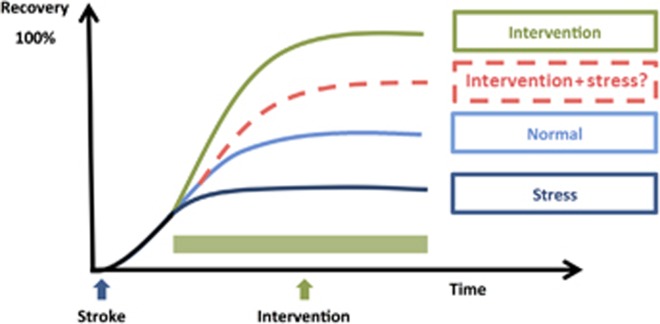Figure 1.
Schematic representation of the potential impact of stress on stroke recovery interventions. The figure illustrates four recovery trajectories: ‘normal' recovery in which animals receive neither exposure to stress nor any neurorestorative intervention; ‘intervention' in which the animal receives only a neurorestorative intervention; ‘stress' in which the animal is exposed to ongoing stress during the recovery period; and ‘intervention+stress' in which the neurorestorative intervention is conducted against a background of ongoing stress. The trajectory for the ‘normal' group is based on numerous reports on the recovery of motor function in rodents.85, 86 Typically, motor performance is significantly degraded by stroke and shows marked improvement across the first 7 to 14 days prior to achieving a relatively stable level, which is substantially below the animals' prestroke level of functioning. The trajectory for the ‘intervention' group is illustrative of the level of improvement that has been documented in animals treated with drugs such as γ-aminobutyric acid antagonists;87 Sphingosine-1-phosphate (S1P) receptor agonists;65 and environmental enrichment.88 The trajectory for the stress group is indicative of the average level of motor impairment described in Refs 42,43,44,45,46,47,48,89. The ‘intervention+stress' group is the only group for which empirical data have not been published. We propose, however, given the broadly negative impact of stress on recovery processes that it is likely to substantially reduce the effectiveness of standard neurorestorative interventions.

